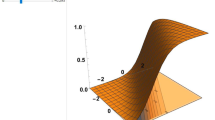Abstract
A model-based modification (SIBTEST) of the standardization index based upon a multidimensional IRT bias modeling approach is presented that detects and estimates DIF or item bias simultaneously for several items. A distinction between DIF and bias is proposed. SIBTEST detects bias/DIF without the usual Type 1 error inflation due to group target ability differences. In simulations, SIBTEST performs comparably to Mantel-Haenszel for the one item case. SIBTEST investigates bias/DIF for several items at the test score level (multiple item DIF called differential test functioning: DTF), thereby allowing the study of test bias/DIF, in particular bias/DIF amplification or cancellation and the cognitive bases for bias/DIF.
Similar content being viewed by others
References
Ackerman, T. (1992).A didactic explanation of item bias, item impact, and item validity from a multidimensional IRT perspective.Journal of Educational Measurement, 29, 67–91.
Ackerman, T. (1992, April).Assessing construct validity using multidimensional item response theory. Paper presented at the 1992 AERA/NCME joint meeting, San Francisco, CA.
Ansley, T. N., & Forsyth, R. A. (1985). An examination of the characteristics of unidimensional IRT parameter estimates derived from two-dimensional data.Applied Psychological Measurement, 9, 37–48.
Dorans, N. J. (1992, November).Implications in choice of metric for DIF effect size on decisions about DIF. Paper presented at the 1991 International Symposium on Modern Theories in Measurement, Montebello, Quebec.
Dorans, N. J., & Kulick, E. (1986). Demonstrating the utility of the standardization approach to assessing unexpected differential item performance on the scholastic aptitude test.Journal of Educational Measurement, 23, 355–368.
Drasgow, F. (1987). A study of measurement bias of two standard psychological tests.Journal of Applied Psychology, 72, 19–30.
Fraser, C. (1983).NOHARM II, A Fortran program for fitting unidimensional and multi-dimensional normal ogive models of latent trait theory (Technical Report). University of New England, Australia.
Hambleton, R. K., & Rogers, H. J. (1989). Detecting potentially biased test items: Comparison of IRT area and Mantel-Haenszel methods.Applied Measurement in Education, 2, 313–334.
Hambleton, R. K., & Swaminanthan, H. (1985).Item response theory: Principles and applications. Boston: Kluwer-Nijhoff Publishing.
Holland, P. W., & Thayer, D. T. (1988). Differential item functioning and the Mantel-Haenszel procedure. In H. Wainer & H. I. Braun (Eds.),Test validity (pp. 129–145). Hillsdale, NJ: Lawrence Erlbaum.
Kok, F. (1988). Item bias and test multidimensionality. In R. Langeheine & J. Rost (Eds.),Latent trait and latent models (pp. 263–275). New York: Plenum Press.
Lautenschlager, G., & Park, D. (1988) IRT item bias detection procedures: Issues of model mis-specification, robustness, and parameter linking.Applied Psychological Measurement, 12, 365–376.
Linn, R., Levine, M., Hastings, C., & Wardrop, J. (1981). Item bias on a test of reading comprehension.Applied Psychological Measurement, 5, 159–173.
Lord, F. M. (1980).Applications of item response theory to practical testing problems. Hillsdale, NJ: Lawrence Erlbaum.
Lord, F. M., & Novick, M. R. (1968).Statistical theories of mental test scores. Reading, MA: Addison-Wesley.
Mellenbergh, G. J. (1982). Contingency table methods for assessing item bias.Journal of Educational Statistics, 7, 105–118.
Meredith, W., & Millsap, R. E. (1992). On the misuse of manifest variables in the detection of measurement bias.Psychometrika, 57, 289–311.
Millsap, R. E., & Meredith, W. (1989, July).The detection of DIF: Why there is no free lunch. Paper presented at the Annual Meeting of the Psychometric Society, University of California at Los Angeles.
Mislevy, R. J., & Bock, R. D. (1984).Item operating characteristics of the Armed Services Aptitude Battery (ASVAB). Form 8A. (Tech. Rep. N00014-83-C-0283). Washington, DC: Office of Naval Research.
Nandakumar, R. (in press).Simultaneous DIF amplification and cancellation: Shealy-Stout's test for DIF. Journal of Educational Measurement.
Raju, N. S., van der Linden, W. J., & Fleer, P. J. (1992, April).An IRT-based internal measure of test bias with applications for differential item functioning. Paper presented at the 1992 AERA meeting, San Francisco, CA.
Reckase, M. D. (1992, April).Mathematics test item formats versus the skill being assessed: A brief review. Paper presented at the 1992 NCME Meeting, San Francisco, CA.
Roussos, L. (1993).Simulation studies of effects of small sample size and studied item parameters on SIBTEST and Mantel-Haenzel Type 1 error performance (Technical Report). Champaign, IL: University of Illinois.
Shealy, R. T. (1989).An item response theory-based statistical procedure for detecting concurrent internal bias in ability tests. Unpublished doctoral dissertation, Department of Statistics, University of Illinois, Urbana-Champaign.
Shealy, R. T., & Stout, W. F. (1991a).An item response theory model for test bias (Tech. Rep. 1991-#2). Washington, DC: Office of Naval Research.
Shealy, R. T., & Stout, W. F. (1991b).A procedure to detect test bias present simultaneously in several items (Tech. Rep. 1991-#3). Washington, DC: Office of Naval Research.
Shealy, R. T., & Stout, W. F. (1993). An item response theory model for test bias and differential test functioning. In (by invitation) P. Holland & H. Wainer (Eds.),Differential item functioning (pp. 197–240). Hillsdale, NJ: Erlbaum.
Stout, W. F. (1987) A nonparametric approach for assessing latent trait unidimensionality.Psychometrika, 52, 589–617.
Swaminathan, H., & Rogers, H. J. (1990). Detecting differential item functioning using logistic regression procedures.Journal of Educational Measurement, 27, 361–370.
Wainer, H. (1993). Model-based standardized measurement of an item's differential impact. In P. Holland & H. Wainer (Eds.),Differential item functioning: theory and practice (pp. 123–136). Hillsdale, NJ: Erlbaum.
Zwick, R. (1990). When do item response function and Mantel-Haenszel definitions of differential item functioning coincide?Journal of Educational Statistics, 15, 185–197.
Author information
Authors and Affiliations
Additional information
This research was partially supported by Office of Naval Research Cognitive and Neural Sciences Grant N0014-90-J-1940, 4421-548 and National Science Foundation Mathematics Grant NSF-DMS-91-01436. The research reported here is collaborative in every respect and the order of authorship is alphabetical. The assistance of Hsin-hung Li and Louis Roussos in conducting the simulation studies was of great help. Discussions with Terry Ackerman, Paul Holland, and Louis Roussos were very helpful.
Rights and permissions
About this article
Cite this article
Shealy, R., Stout, W. A model-based standardization approach that separates true bias/DIF from group ability differences and detects test bias/DTF as well as item bias/DIF. Psychometrika 58, 159–194 (1993). https://doi.org/10.1007/BF02294572
Issue Date:
DOI: https://doi.org/10.1007/BF02294572




